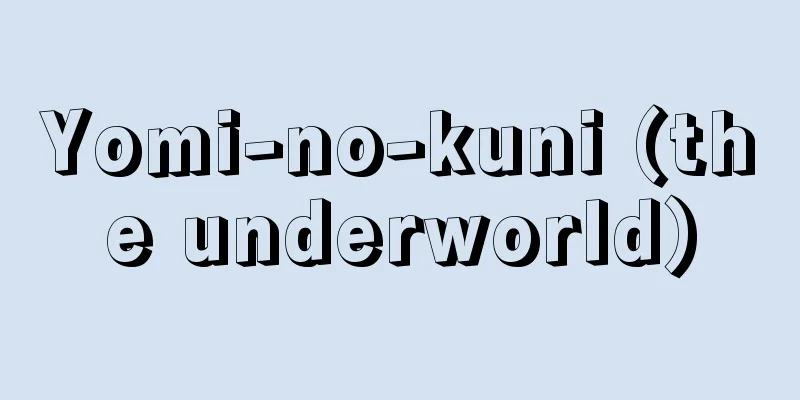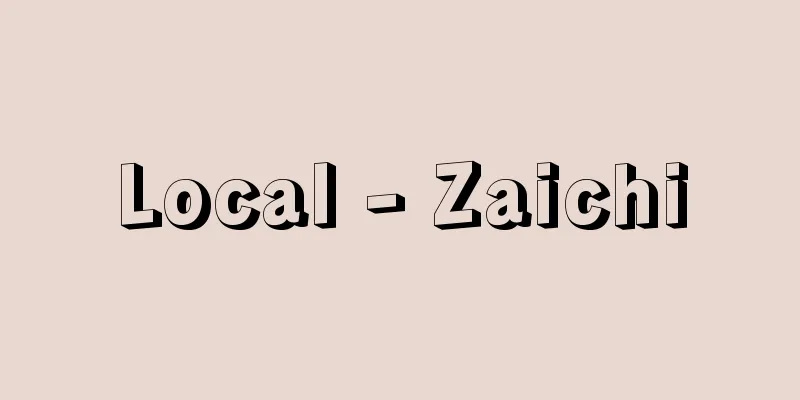Yomi-no-kuni (the underworld)

|
Also written as Senkoku, it originally meant a mountainous afterlife, but since tombs were often built on mountain hills, it also meant the land of the dead. In both cases, Yomi (Kousen) and Senka (underworld) are the Chinese names for the place where the dead go, and the Kojiki contains a myth of a visit to Yomi-no-kuni, which is set in Yomi-no-kuni. Izanagi-no-mikoto follows Izanami-no-mikoto, who had become ill after giving birth to the fire god and traveled to Yomi-no-kuni, into this world, hoping to return together. However, Izanami-no-mikoto has already eaten food from the land of the dead, so he negotiates with Yomi-no-tsu-no-Okami on the condition that Izanagi-no-mikoto not look at him. As this took a long time, the god broke a comb pole and lit a fire, but what appeared was an ugly goddess with maggots crawling around making noise and snakes occupying various parts of her body. The god fled in fear, so the god had the ugly women chase him, while the god threw his wig and comb, which turned into wild grapes and bamboo shoots, which the ugly women ate as he fled. When the underworld army pursued him, he fled while waving his sword backwards, and finally drove them off by hitting them with a peach. He placed a huge stone on the border between the underworld and the underworld, where he confronted the goddess and severed all ties with her. The goddess then declared that she would kill 1,000 people a day, and the god would build 1,500 birthing huts a day. There are various viewpoints on this myth, but it is distinctive in that the situation in Yomi-no-kuni is described as a dark and gloomy world. In the early Kofun period, the dead were considered to be priests or gods, and the underworld was not yet a gloomy world. Therefore, it is assumed that this gloominess began after the adoption of the continental belief in the spirits and gods of plague, and the adoption of the continental style of late Kofun tombs, which are led by a passageway to a horizontal stone chamber that can be seen as the world of the dead. The Izumo-no-kuni Fudoki, in the section on Izumo County, speaks of the existence of Yomi-no-ana at Nazukiiso, and that if one reaches this place in a dream, one will surely die. As the concept of the underworld changed, the idea that the underworld was the land of the dead emerged, and eventually it became associated with Ne-no-kuni. In the mythology of Yomi-no-kuni, the border with Yomi-no-kuni is Ifuyasaka in Izumo Province, and Izanami-no-Mikoto is said to have been buried on Mount Hiba, which is on the border between Izumo and Hahaki Provinces, which is meant to imply a strong connection between Izumo Province and Yomi-no-kuni. [Yoshii Iwao] Source: Shogakukan Encyclopedia Nipponica About Encyclopedia Nipponica Information | Legend |
|
泉国とも書き、本来は山岳的他界を表すが、墳墓を山丘に営むことが多いことから死者の国をいう。いずれも中国で死者の赴く所を黄泉(こうせん)、泉下(せんか)ということによっており、『古事記』には、黄泉国を舞台とした黄泉国訪問神話がある。伊弉諾尊(いざなぎのみこと)は、火神を生んだために病んで黄泉国に移った伊弉冉(いざなみ)尊を追ってこの世界に入り、ともに帰ることを願う。しかし伊弉冉尊はすでに死の国の食をとっていたため、私の姿を見るなという条件を伊弉諾尊に誓わせて黄泉津(よもつ)大神と交渉する。その時間が長いので、男神は櫛(くし)の柱を折って火をともすが、そこに現れたのは蛆(うじ)が音をたてて這(は)いまわり、蛇が身体の各部に占拠する醜悪な女神の姿であった。恐れて逃げる男神を、女神は醜女(しこめ)たちに追わせ、一方、男神は鬘(かずら)や櫛を投げ、それが野葡萄(のぶどう)や筍(たけのこ)となり、醜女がこれを食う間に逃げた。黄泉軍(よもついくさ)が追うときには剣を後方に向け振りつつ逃げ、桃の実で打ってやっと撃退した男神は、黄泉国との境に巨石を据え、ここで女神と対決し絶縁する。そして、女神は日に1000人を殺し、男神は日に1500の産屋(うぶや)を建てると宣言する。 この神話には種々な観点があるが、黄泉国の状況が暗黒陰惨な世界として語られていることに特色がある。古墳時代前期では、死者は司祭者あるいは神と考えられており、冥界(めいかい)はまだ陰惨な世界ではなかった。したがってこの陰惨化は、大陸の御霊(ごりょう)信仰や疫神信仰の受け入れ、また羨道(せんどう)によって死者の世界と見うる横穴式石室に導かれる、大陸様式の後期古墳の採用以後始まったものと推定されている。『出雲国風土記(いずものくにふどき)』出雲郡の条には、脳(なずき)の磯(いそ)に黄泉穴(よみのあな)の存在が語られており、夢でここに至ればかならず死ぬと伝えられる。冥界観の変化とともに、地底を死者の国とする観念が生じ、やがて根(ね)の国(くに)との関連が生ずるのである。なお黄泉国の神話では、黄泉国との境を出雲国の伊賦夜坂(いふやさか)とし、また出雲と伯伎(ははき)両国の境にある比婆山(ひばのやま)に伊弉冉尊を葬したというが、これは出雲国と黄泉国との強い関連を暗示しようとしている。 [吉井 巖] 出典 小学館 日本大百科全書(ニッポニカ)日本大百科全書(ニッポニカ)について 情報 | 凡例 |
<<: Songs of unknown author - Songs of unknown author
>>: Yomitan [village] - Yomitan
Recommend
Cuba - Cuba (English spelling)
Cuba is a country that consists of Cuba, the larg...
Commercial accounting books - Shogyochobo
A book that merchants are required to prepare for...
Thoracic vertebrae
Of the spine, Cervical spine Watch The twelve vert...
Kortschak, HP (English) KortschakHP
…Their research was first carried out using unice...
Secunderabad (English spelling)
...To distinguish it from the city of the same na...
Milnor, JW
...Analysis on differential manifolds is an impor...
Liriodendron chinense (English name) Liriodendronchinense
…[Kunihiko Ueda]. … *Some of the terminology that...
actor sequitur forum rei (English spelling) actorsequiturforumrei
...Plaintiffs want to file lawsuits in a court as...
Kienböck's disease
Also known as lunate softening, this is a disease...
Kin Okawa
...Livestock farming of beef cattle, dairy cattle...
Sukumo [city] - Sukumo
A city in the southwest of Kochi Prefecture. It wa...
Nobuyuki - Shingyo
A monk from the Sui Dynasty in China. The founder...
Stem - Gokan
A component of a word to which an affix can be at...
Ring-necked sword
…In recent years, bronze swords have been excavat...
Buried Valley
...they are generally filled with thick deposits ...









